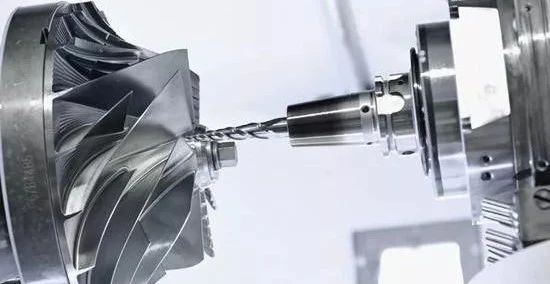Why do we think titanium alloy is a difficult material to machine? Because of the lack of deep understanding of its processing mechanism and phenomenon.

1. Physical Phenomena of Titanium Machining
The cutting force of titanium alloy processing is only slightly higher than that of steel with the same hardness, but the physical phenomenon of processing titanium alloy is much more complicated than that of processing steel, which makes titanium alloy processing face great difficulties.
The thermal conductivity of most titanium alloys is very low, only 1/7 of steel and 1/16 of aluminum. Therefore, the heat generated in the process of cutting titanium alloy will not be quickly transferred to the workpiece or taken away by chips, but will be accumulated in the cutting area, and the generated temperature can be as high as 1000 ° C, causing the cutting edge of the tool to wear, crack and die rapidly. Build-up edge build-up, rapid appearance of worn edges, in turn generates more heat in the cutting zone, further shortening tool life.
The high temperature generated during the cutting process also destroys the surface integrity of titanium alloy parts, resulting in a decrease in the geometric accuracy of the part and a work hardening phenomenon that seriously reduces its fatigue strength.
The elasticity of titanium alloys can be beneficial for part performance, but during cutting, the elastic deformation of the workpiece is an important cause of vibration. The cutting pressure causes the “elastic” workpiece to leave the tool and rebound, so that the friction between the tool and the workpiece is greater than the cutting action. The friction process also generates heat, which aggravates the problem of poor thermal conductivity of titanium alloys.
This problem is even more serious when processing thin-walled or ring-shaped parts that are easily deformed. It is not an easy task to process titanium alloy thin-walled parts to the expected dimensional accuracy. Because when the workpiece material is pushed away by the tool, the local deformation of the thin wall has exceeded the elastic range to produce plastic deformation, and the material strength and hardness at the cutting point increase significantly. At this time, the machining at the originally determined cutting speed becomes too high, which further leads to sharp wear of the tool.
“Heat” is the “culprit” for the difficulty of processing titanium alloys!
2. Technological know-how for processing titanium alloys
On the basis of understanding the processing mechanism of titanium alloys, coupled with past experience, the main process know-how for processing titanium alloys is as follows:
(1) Inserts with positive angle geometry to reduce cutting force, cutting heat and deformation of workpiece.
(2) Keep a constant feed to avoid hardening of the workpiece. The tool should always be in the feed state during the cutting process. The radial cutting amount ae should be 30% of the radius during milling.
(3) High-pressure and large-flow cutting fluid is used to ensure the thermal stability of the machining process and prevent the workpiece surface from degeneration and tool damage due to excessive temperature.
(4) Keep the cutting edge of the blade sharp, blunt knives are the cause of heat buildup and wear, which can easily lead to the failure of the knives.
(5) Processing in the softest state of titanium alloy as possible, because the material becomes more difficult to process after hardening, heat treatment improves the strength of the material and increases the wear of the blade.
(6) Use a large nose radius or chamfer to cut as much as possible into the cutting edge. This can reduce the cutting force and heat at each point and prevent local breakage. When milling titanium alloys, among the cutting parameters, the cutting speed has the greatest influence on the tool life vc, followed by the radial cutting amount (milling depth) ae.
Xinfa CNC tools have the characteristics of good quality and low price. For details, please visit:
CNC Tools Manufacturers – China CNC Tools Factory & Suppliers (xinfatools.com)
3. Solving titanium processing problems starting from the blade
The blade groove wear that occurs during titanium alloy processing is the local wear of the back and front along the depth of cut direction, which is often caused by the hardened layer left by the previous processing. The chemical reaction and diffusion between the tool and the workpiece material at a processing temperature exceeding 800°C is also one of the reasons for the formation of groove wear. Because during the processing, the titanium molecules of the workpiece accumulate in the front of the blade, and are “welded” to the blade under high pressure and high temperature, forming built-up edge. When built-up edge peels away from the cutting edge, it takes away the carbide coating of the insert, so titanium machining requires special insert materials and geometries.
4. Tool structure suitable for titanium machining
The focus of titanium alloy processing is heat. A large amount of high-pressure cutting fluid must be sprayed onto the cutting edge in a timely and accurate manner to remove heat quickly. There are unique structures of milling cutters specially used for titanium alloy processing on the market.
Post time: Aug-09-2023



